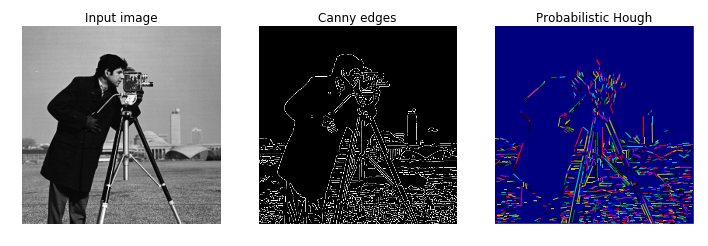python數字影象處理(15):霍夫線變換
在圖片處理中,霍夫變換主要是用來檢測圖片中的幾何形狀,包括直線、圓、橢圓等。
在skimage中,霍夫變換是放在tranform模組內,本篇主要講解霍夫線變換。
對於平面中的一條直線,在笛卡爾座標系中,可用y=mx+b來表示,其中m為斜率,b為截距。但是如果直線是一條垂直線,則m為無窮大,所有通常我們在另一座標系中表示直線,即極座標系下的r=xcos(theta)+ysin(theta)。即可用(r,theta)來表示一條直線。其中r為該直線到原點的距離,theta為該直線的垂線與x軸的夾角。如下圖所示。
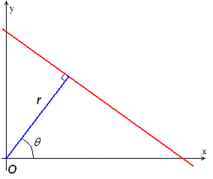
對於一個給定的點(x0,y0), 我們在極座標下繪出所有通過它的直線(r,theta),將得到一條正弦曲線。如果將圖片中的所有非0點的正弦曲線都繪製出來,則會存在一些交點。所有經過這個交點的正弦曲線,說明都擁有同樣的(r,theta), 意味著這些點在一條直線上。
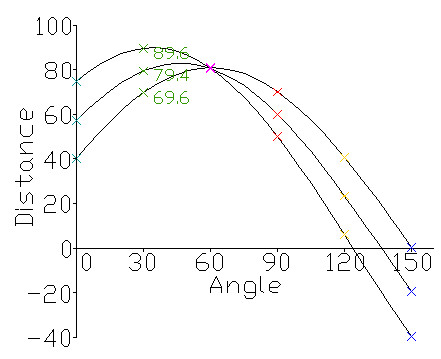
發上圖所示,三個點(對應圖中的三條正弦曲線)在一條直線上,因為這三個曲線交於一點,具有相同的(r, theta)。霍夫線變換就是利用這種方法來尋找圖中的直線。
函式:skimage.transform.hough_line(img)
返回三個值:
h: 霍夫變換累積器
theta: 點與x軸的夾角集合,一般為0-179度
distance: 點到原點的距離,即上面的所說的r.
例:

import skimage.transform as st import numpy as np import matplotlib.pyplot as plt # 構建測試圖片 image = np.zeros((100, 100)) #背景圖 idx = np.arange(25, 75) #25-74序列 image[idx[::-1], idx] = 255 # 線條\ image[idx, idx] = 255 # 線條/ # hough線變換 h, theta, d = st.hough_line(image) #生成一個一行兩列的視窗(可顯示兩張圖片). fig, (ax0, ax1) = plt.subplots(1, 2, figsize=(8, 6)) plt.tight_layout() #顯示原始圖片 ax0.imshow(image, plt.cm.gray) ax0.set_title('Input image') ax0.set_axis_off() #顯示hough變換所得資料 ax1.imshow(np.log(1 + h)) ax1.set_title('Hough transform') ax1.set_xlabel('Angles (degrees)') ax1.set_ylabel('Distance (pixels)') ax1.axis('image')

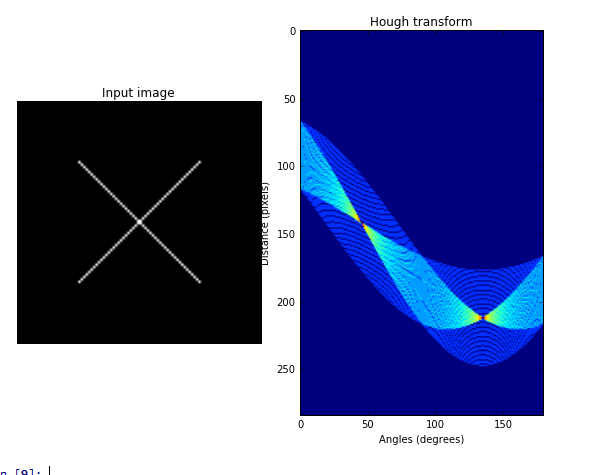
從右邊那張圖可以看出,有兩個交點,說明原影象中有兩條直線。
如果我們要把圖中的兩條直線繪製出來,則需要用到另外一個函式:
skimage.transform.hough_line_peaks(hspace, angles, dists)
用這個函式可以取出峰值點,即交點,也即原圖中的直線。
返回的引數與輸入的引數一樣。我們修改一下上邊的程式,在原圖中將兩直線繪製出來。

import skimage.transform as st import numpy as np import matplotlib.pyplot as plt # 構建測試圖片 image = np.zeros((100, 100)) #背景圖 idx = np.arange(25, 75) #25-74序列 image[idx[::-1], idx] = 255 # 線條\ image[idx, idx] = 255 # 線條/ # hough線變換 h, theta, d = st.hough_line(image) #生成一個一行三列的視窗(可顯示三張圖片). fig, (ax0, ax1,ax2) = plt.subplots(1, 3, figsize=(8, 6)) plt.tight_layout() #顯示原始圖片 ax0.imshow(image, plt.cm.gray) ax0.set_title('Input image') ax0.set_axis_off() #顯示hough變換所得資料 ax1.imshow(np.log(1 + h)) ax1.set_title('Hough transform') ax1.set_xlabel('Angles (degrees)') ax1.set_ylabel('Distance (pixels)') ax1.axis('image') #顯示檢測出的線條 ax2.imshow(image, plt.cm.gray) row1, col1 = image.shape for _, angle, dist in zip(*st.hough_line_peaks(h, theta, d)): y0 = (dist - 0 * np.cos(angle)) / np.sin(angle) y1 = (dist - col1 * np.cos(angle)) / np.sin(angle) ax2.plot((0, col1), (y0, y1), '-r') ax2.axis((0, col1, row1, 0)) ax2.set_title('Detected lines') ax2.set_axis_off()

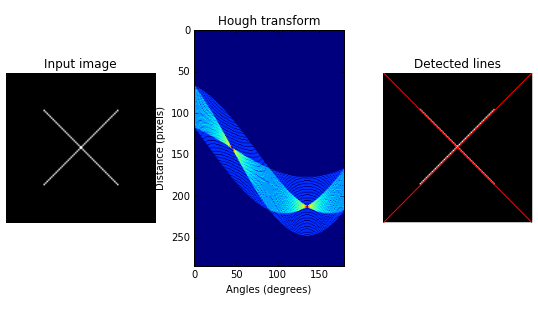
注意,繪製線條的時候,要從極座標轉換為笛卡爾座標,公式為:

skimage還提供了另外一個檢測直線的霍夫變換函式,概率霍夫線變換:
skimage.transform.probabilistic_hough_line(img, threshold=10, line_length=5,line_gap=3)
引數:
img: 待檢測的影象。
threshold: 閾值,可先項,預設為10
line_length: 檢測的最短線條長度,預設為50
line_gap: 線條間的最大間隙。增大這個值可以合併破碎的線條。預設為10
返回:
lines: 線條列表, 格式如((x0, y0), (x1, y0)),標明開始點和結束點。
下面,我們用canny運算元提取邊緣,然後檢測哪些邊緣是直線?

import skimage.transform as st import matplotlib.pyplot as plt from skimage import data,feature #使用Probabilistic Hough Transform. image = data.camera() edges = feature.canny(image, sigma=2, low_threshold=1, high_threshold=25) lines = st.probabilistic_hough_line(edges, threshold=10, line_length=5,line_gap=3) # 建立顯示視窗. fig, (ax0, ax1, ax2) = plt.subplots(1, 3, figsize=(16, 6)) plt.tight_layout() #顯示原影象 ax0.imshow(image, plt.cm.gray) ax0.set_title('Input image') ax0.set_axis_off() #顯示canny邊緣 ax1.imshow(edges, plt.cm.gray) ax1.set_title('Canny edges') ax1.set_axis_off() #用plot繪製出所有的直線 ax2.imshow(edges * 0) for line in lines: p0, p1 = line ax2.plot((p0[0], p1[0]), (p0[1], p1[1])) row2, col2 = image.shape ax2.axis((0, col2, row2, 0)) ax2.set_title('Probabilistic Hough') ax2.set_axis_off() plt.show()

